Spotlight on David Walter Banks
Oct 31, 2011
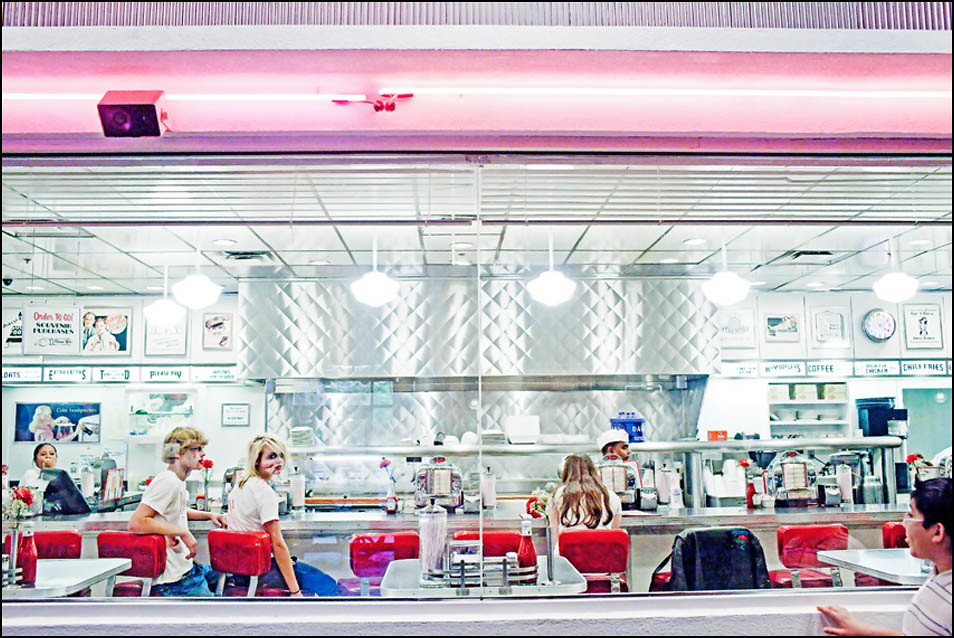
DAVID:
I used to put so much stress on myself during project brainstorming
that the thought process would become paralyzing. In my mind there
was no reason to start on a project unless it was fully formulated,
unique, and something that really excited me. The result was a lot
of thinking and writing and dwelling on ideas without any substantial
conclusions, and subsequently, no new project work.
After repeating this cycle for a while, I just picked an idea and started
shooting large gatherings of people who shared a common interest. It
didn't feel right, but it was better than siting on my hands. This image
was born from one of these early shoots at the end of a 'zombie walk'
in downtown Atlanta. After the hoard of zombies dispersed, I began
the hike back to my car, where I saw these two bloody-faced kids sitting
in a 50s-style diner and photographed it quickly in passing.
The rest of the images I shot at these various gatherings were all directed
strobe and fairly stylized, yet it was this image that continued to resonate
with me. At first I didn't know why, and so I kept coming back to the
photograph. Finally I realized that it was the human interaction with this
altered reality that interested me so much. After a few more revisions of
the idea and a lot of talk with my colleagues in LUCEO, my essay entitled
'The Fourth Wall' emerged from the ashes of the earlier failed concept.
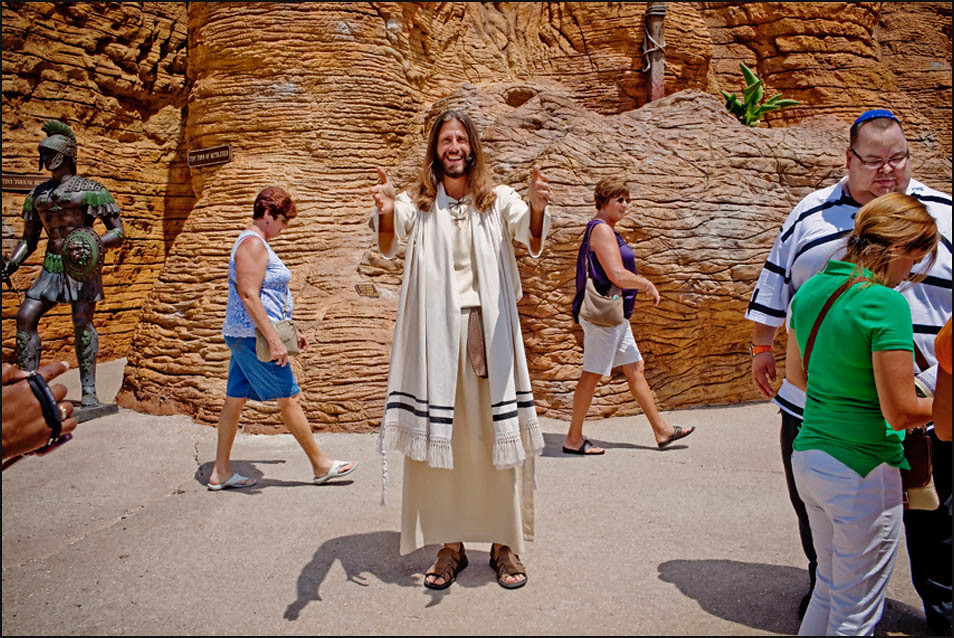
(An actor playing Jesus stands with his arms outstretched greeting visitors
at the Christian theme park, Holy Land Experience, in Orlando, Florida. The
religious tourist attraction serves as a mix between a place for worship,
historic study, and a large scale three-dimensional stage for the daily live
performances.)
TID:
Lets talk in greater detail about the fourth wall, what it represents,
and how you approach making images for it.
DAVID:
‘The Fourth Wall’ is a theatrical term for the invisible barrier that separates
the audience from the fictional characters on stage. More often, the phrase
is used in reference to breaking that wall down.
As children with wild imaginations, we are taught that the world is separated
into reality and fantasy, fiction and non-fiction. These early teachings are
perhaps what plant the seeds of curiosity in pretending we are in a place or
time that we are not. In the 1950s, Walt Disney fueled this fire when he set
out to create a fantasy world that was designed and marketed not just to
children, but adults as well, paving the way for more like it. The Fourth
Wall explores these altered theatrical realities and our interaction and
fascination with them.
My approach for making these images is actually quite different from how
I normally go about making images. In other projects, and most of my daily
work, I attempt to put as much of myself as possible into the photographs to
the point that every image is almost a self-portrait in a way. I shoot very
objectively and work to create an intimate connection with my subjects,
whether it's a close friend, complete stranger, or even a place or object.
For this project, I'm trying to document these places as more of a sociological
study. I want it to feel as though the perspective is that of someone on the
outside looking in - almost voyeuristic in a way. However, I'm finding this
to be more and more difficult the longer I work on the project, the more
I feel connected to these fantasy worlds and that inner need for escape.

(Guests at the Atlantis Resort on Paradise Island in the Bahamas at one of
the many lagoon-styled pools on the resort's property. Themed for it's
namesake, Atlantis offers a complex with a water-park, aquarium, casino,
spa, six hotels, a fitness center, golf, shopping, a speedway, a night club,
and a plethora of dining options, all linked with an array of fake lagoons,
Atlantis encourages guests to stay on property. In fact, they make it kind of
difficult to leave. At Atlantis, you are literally offered complete immersion into
this surreal play-land for your entire vacation.)
TID:
How has the project shifted from the beginning to where it is now?
DAVID:
As I said above, the work evolved from a project tentatively titled
'Gatherings' in which LUCEO photographer Kendrick Brinson and I
were visiting mass gatherings of folks with common interests. This idea
eventually fizzled out due to lack of focus and direction. The photograph
above, titled unimaginatively as 'Zombie Diner' led me down a new path
of thought. That idea's first incarnation was tentatively titled 'False Identity',
and I began to visit these fake realities. The idea continued to grow but
connotations that came along with the words 'false', and 'fake', seemed so
negative and I didn't want to convey a sense of deceit in my viewpoint.
After a long talk with the LUCEO photographers at one of our bi-annual
meetings in DC, the new title and new direction became clear. It wasn't the
places alone that interested me, but the human interaction with these places.
From there, my purpose and what I was looking for finally became clear. I
say all this to emphasize that our ideas for what, who, and where we shoot
don't always need to be clear from the start. Sometimes we may have a
specific mission that we can understand and articulate before we ever make
the first frame, but other times it needs to be more of a natural evolution. I
also believe that we need to make use of our own photographic community
to better understand ourselves and our work, which can seem so unclear
even when staring us right in the face. It's hard to recognize when we're
wearing blinders.
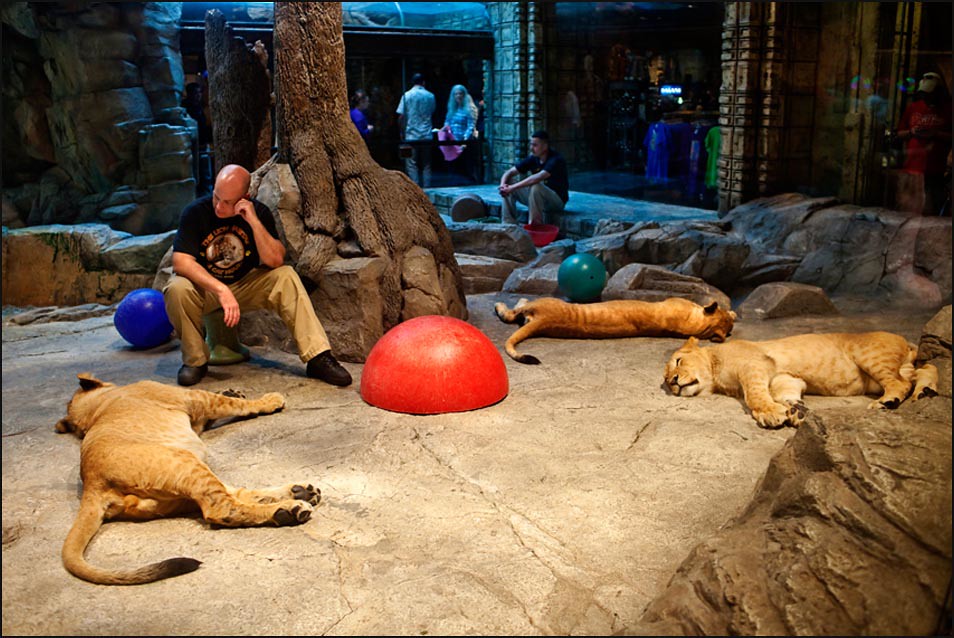
(A trainer inadvertently mimics the behavior of the large cats inside the
Lion Habitat inside the MGM Grand Hotel & Casino on the infamous Las
Vegas Strip. This was shot during a trip to Vegas shooting exclusively
for this project.)
TID:
What goes through your mind when you approach making images for
the project - talk about the idea of the cracks as we talked about.
DAVID:
I'm looking for the sense of fantasy and the interaction of the 'audience'
in these altered realities. I'm looking to convey these places as trips to
another world, but I also hope to create punctuations throughout the work
focusing on the cracks in the facade.
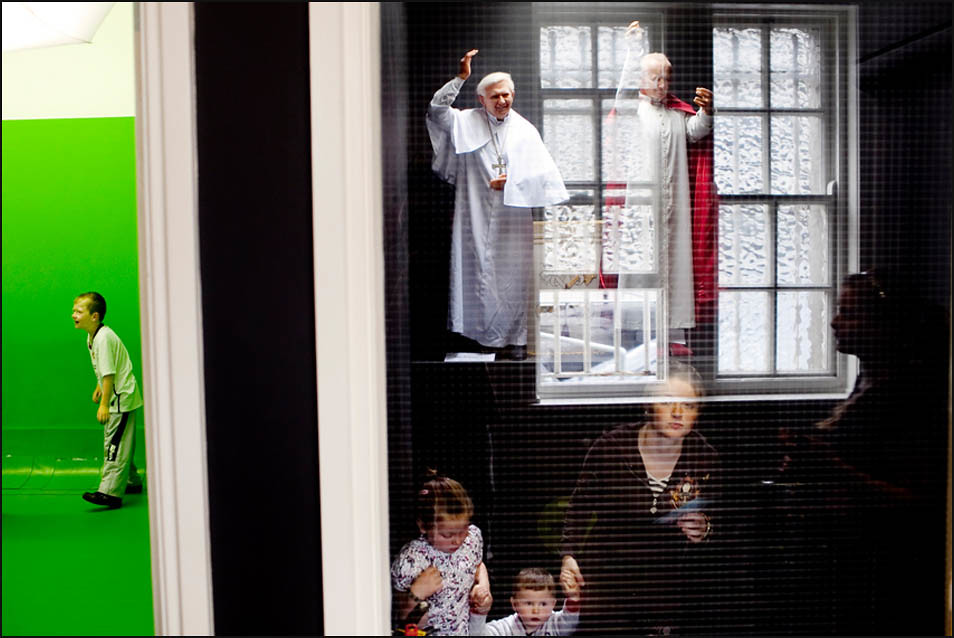
(Tourists explore The National Wax Museum in Dublin, Ireland where visitors
are invited on a tour through Irish History followed by an odd mix of popular
culture ranging from fairy tales and music to horror films, all depicted by
magnificently crafted wax sculptures.)
TID:
What have you learned from this working on this project that you didn't
know before.
DAVID:
Through this project I've found that my real interest in photography is routed
in sociological exploration as much as it is the image-making. I've also come
to terms with the fact that for me so much of these explorations are to better
understand myself. As self-involved as it may sound, the images and the
projects become a self portrait. It's not that I don't have a profound respect
and interest in my subjects in their own right, because I certainly do. It's more
the opposite outcome, as this self-reflection deepens my interest and curiosity
with what I shoot. In a strange roundabout way, this project helped lead me to
my next piece that will be based on my hometown of Atlanta.
TID:
Since this project is self generated, what advice do you have for
photographers looking to work on long-term themes where
at least initially there was no commissioning publication?
DAVID:
You don't need anyone to give you permission to document life and create
art on your own terms.
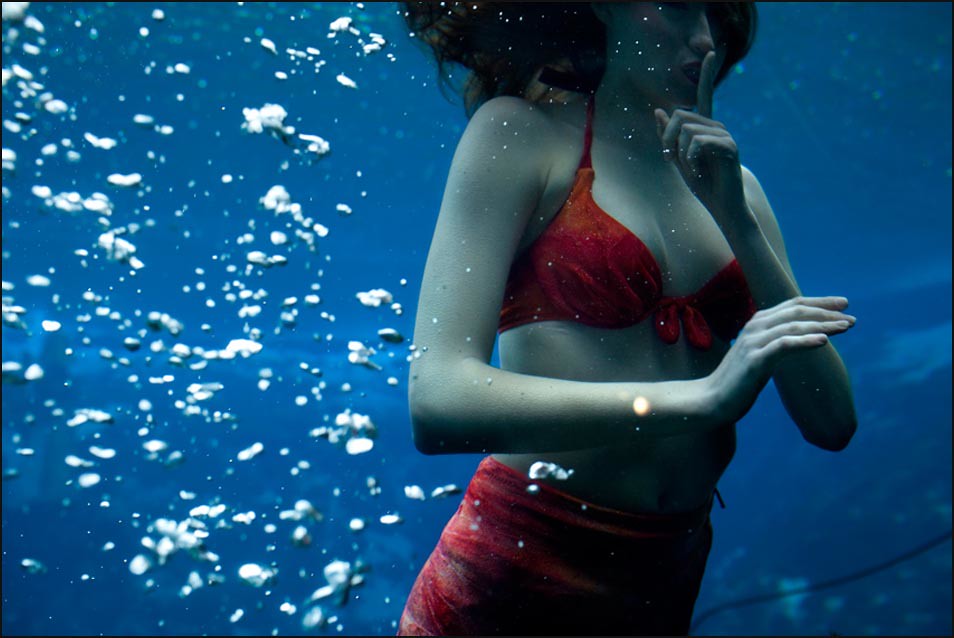
(One of the mermaid actresses holds a finger to her mouth to hush the
crowd while performing Hans Christian Andersen's 'The Little Mermaid' in
the underwater theatre in Weeki Wachee State Park in Spring Hill, Florida.)
That's my passionate gut reaction on the subject, but it would be a disservice
if I don't also mention the practical side of it all. You can sit around and wait
for a great assignment, or commission, to shoot exactly what you want, but it
probably won't happen. You have to make it happen, and often times this
means to fund and operate on your own at first. From the very beginning,
though, we should be pitching these story ideas to editors and art directors,
and I think a lot of photographers will be surprised with positive results.
There are also a whole plethora of grant and competition funding out there
that should be researched to find the right fit for your project.
TID:
What sort of problems have you run into, and how do you
problem solve?
DAVID:
I've approached this project from a more street-photography style, and
ended up mostly as an observer. I make no claim however that I'm not being
completely objective in the story I tell by the direction I point my camera and
the instant I shoot the image. This was a moment when one of these fantastical
places broke that barrier of the fourth wall and interacted with me. As I go
forward, I hope to look for more opportunities to directly interject myself when
appropriate.
Funding is definitely an ongoing issue for any photographer looking to
generate their own stories. In my opinion, there's no magic bullet, and it's
more of a cumulative effect of many different efforts. To solve this problem
I apply for grants, pitch the stories to publications in smaller bite-sized pieces,
and work to resell stock from the project. For each project, there's a different
answer and a different means of funding. I also look at assignment work as a
direct means of funding personal work, rather than just a paycheck. We
created the LUCEO Project Fund in which a percentage of each commission
goes into an account that directly pays for project work that lacks funding.
This way our clients know that they are helping pay for the work which
probably spurred them to hire us in the first place.
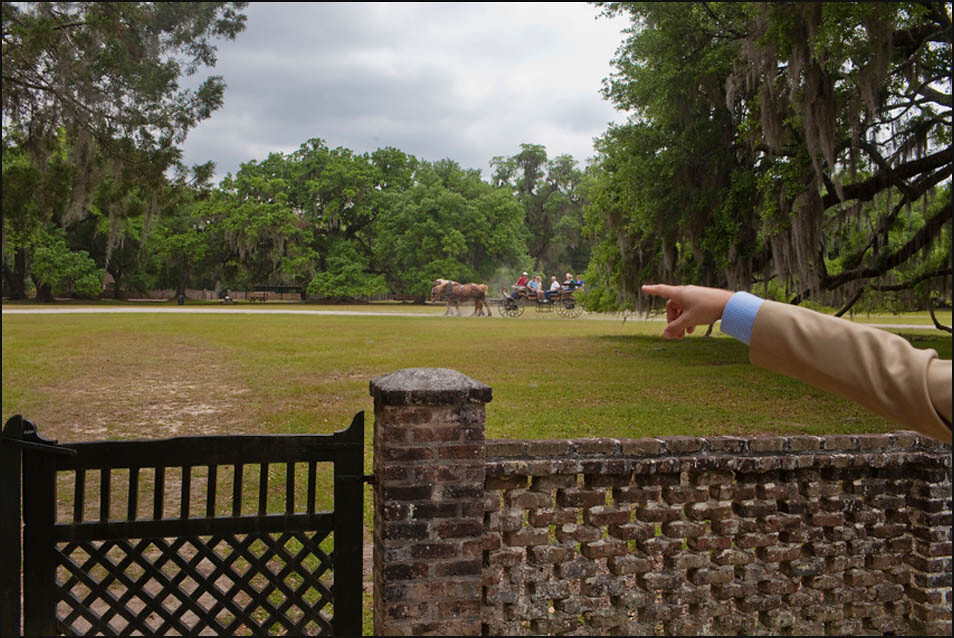
(This photo came from a beautiful wedding I documented at an old
plantation in Charleston, South Carolina, in a passing instant in time
between two destinations. The moral here being that you never know
when a piece of the puzzle will fall into place right in front of you.)
TID:
I love it when photographers think out of the box, and I think this
is an excellent example. What advice do you have for photographers
to expand their mind?
DAVID:
I would suggest to look outside photography, or at least outside their realm
of photography. If you're a photojournalist, look at more art photography.
If you're a portrait photographer, look at more documentary photography. Or
look to film, music, poetry, contemporary and historic painting, or even the
social sciences. All this to say that I believe it's important to remind ourselves
that the camera is just a tool we use to express ourselves.
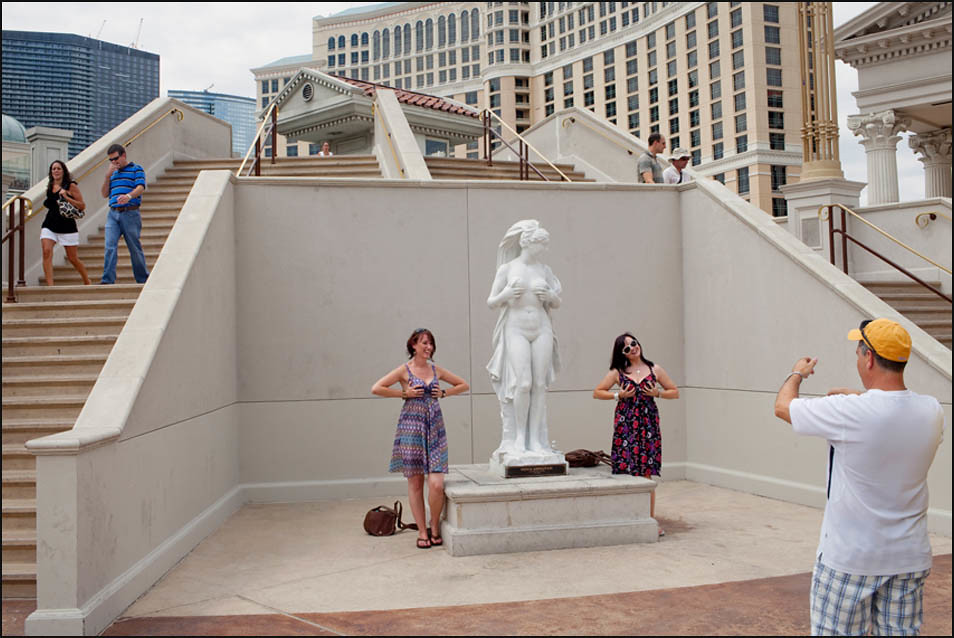
(I had been standing and photographing the statues and surrounding
stairs on two separate trips to the same spot in Vegas. Finally this
scene materialized right in front of me. I'm starting to look for more
specific ideas when I approach these places as I collect a growing pile
of images. For Vegas, one of the obvious ideas to look for was sin,
and the wild sexual behavior of average people.)
I'm looking for a range of different emotions when I approach these
shoots. I feel that it's important not to take ourselves as photographers
too seriously, and I feel the same way with this project, so I want to find
a little quirk. Never in a judgmental or insulting way, but in a lighthearted
shared humor. I believe my better half, Kendrick Brinson, has achieved
a mastery of the shared wink through her images in Sun City.
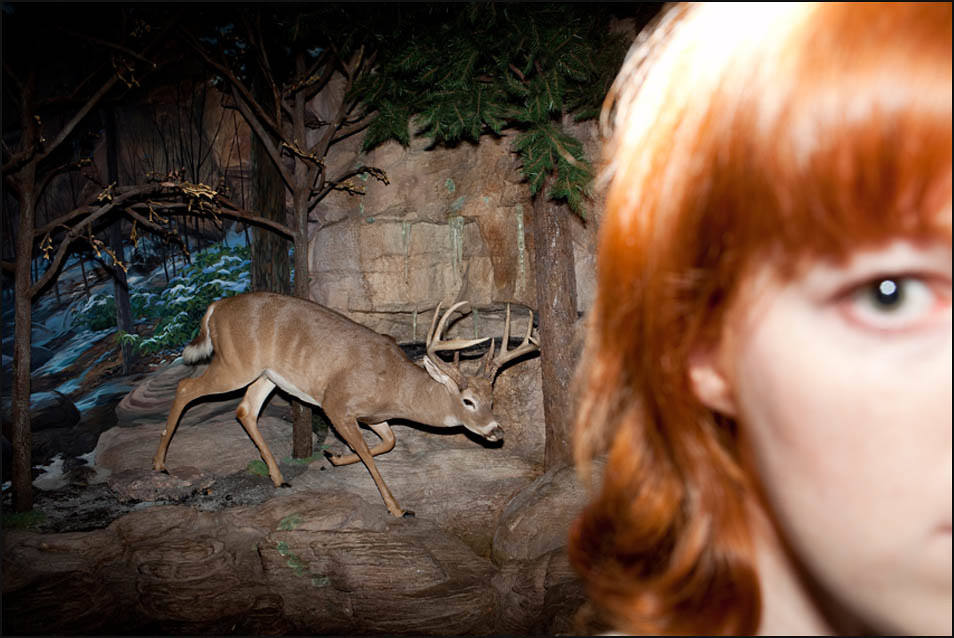
(This image was shot on my birthday of Kendrick Brinson in front of the 'Walk
Through Time in Georgia' exhibit at Fernbank Natural History Museum in
Atlanta, Georgia. Yes, I'm that much of a photography nerd that I spend my
birthday working on a project.)
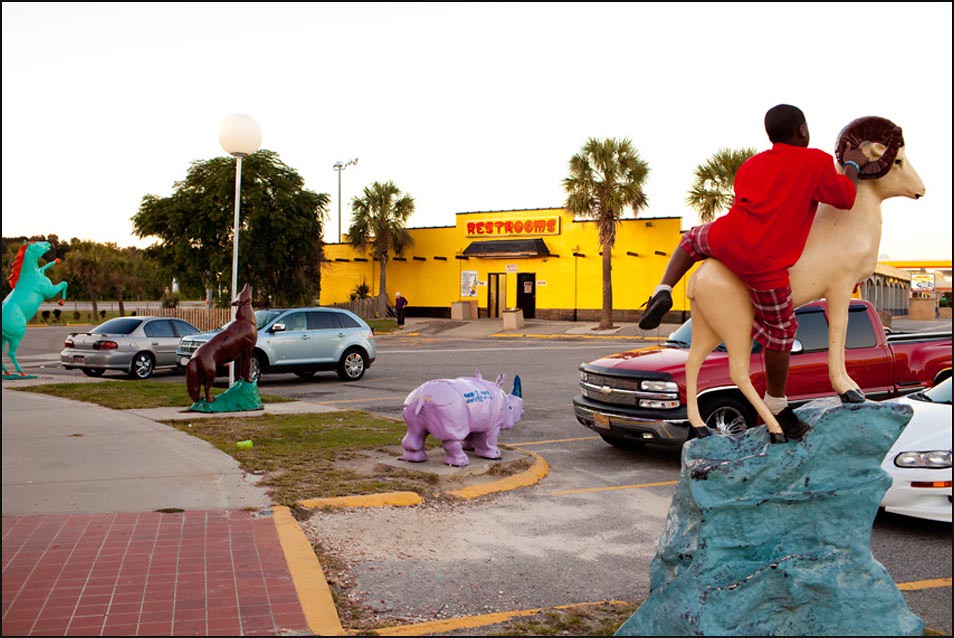
SA young boy climbs one of the many painted stone statues at the infamous
South of the Border compound off of Interstate 95 in Dillon, South Carolina.
The massive billboard campaign lures travelers for nearly one hundred miles
of Interstate 95 with quirky messaging and a politically-incorrect stereotyped
caricature of a bandito. The Mexico-themed roadside attraction began when
Alan Schafer started a small beer-stand, conveniently located just across the
border from a dry county in North Carolina.
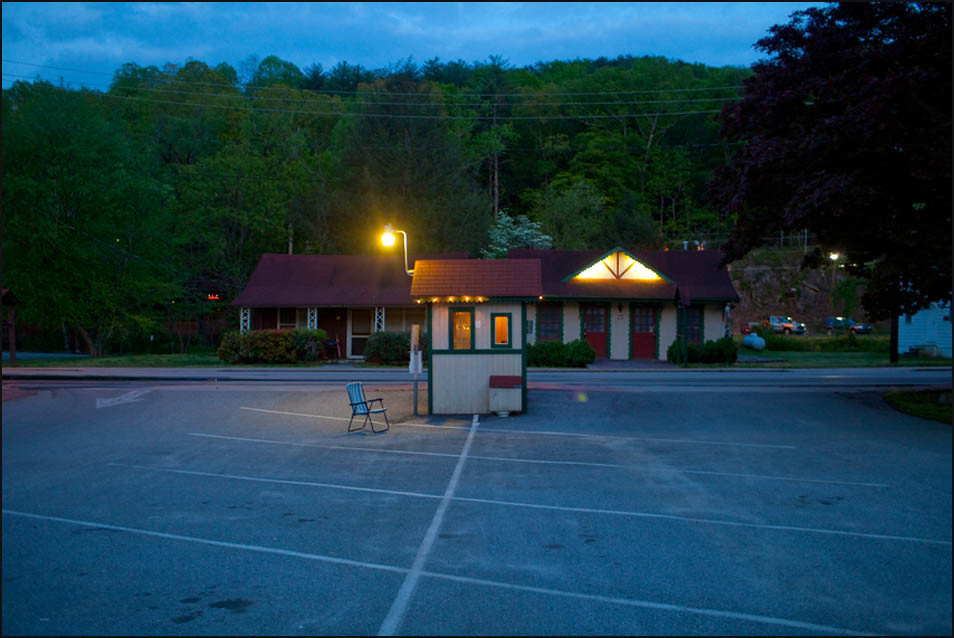
(An abandoned parking lot at dusk in downtown Helen, Georgia. The small
town presents itself as a re-creation of an alpine village complete with
cobblestone alleys, horse-drawn carriages and old-world towers. I try to
make images that convey a feeling, and this photograph offers me a quiet
exit from this fantasy world.)
For me, photography is an intimate and intricate part of my existence,
and I try to live what Sam Abell terms as 'The Photographic Life'. So I
compulsively document my own life on top of assignment and project work,
which oftentimes yields some of my favorite images and blends together.
A lot of what we talk about as photographers is not the way an image looks,
but how it feels. My ideal world, and what I strive to do, is to convey a
mood, as much as a literal fact.
+++++
David Walter Banks (b. 1982) is an American born photographer living in Atlanta, Georgia. He is a conceptually based documentary and portrait photographer, and a founding member of the photographic cooperative LUCEO Images. His work is aimed at questioning the way in which we view the everyday reality around us. Banks was a finalist for the 2010 Magnum Expression Award, and was a selected artist for the Magenta Foundation Flash Forward 2009 and 2011 Census of Emerging Photographers. His work was exhibited at the 2009 and 2011 LOOK3 Festival of the Photograph, the 2010 LOOKbetween Festival, the Aperture Gallery in New York, the Houston Center for Photography, and most recently at Jennifer Schwartz Gallery in Atlanta and 25CPW in New York City. David’s clients have included The New York Times, Stern Magazine, TIME Magazine, US News & World Report, GQ, Forbes Magazine, The Wall Street Journal, People Magazine, ESPN The Magazine, The FADER Magazine, AARP Bulletin, Golf Digest, Spin Magazine, XXL Magazine, Sporting News, Bloomberg News and Atlanta Magazine among others.
+++++
Next week on TID, we'll take a look behind this image from TID co-editor,
Logan Mock-Bunting, with some valuable words of wisdom on covering
wildfires:
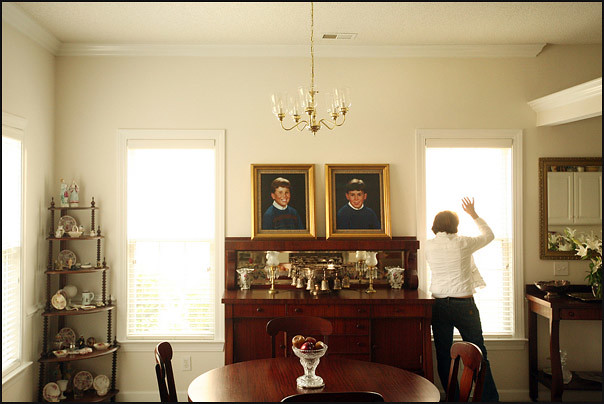
As always, if you have a suggestion of someone, or an image you
want to know more about, contact Ross Taylor at: [email protected].
For FAQ about the blog see here: